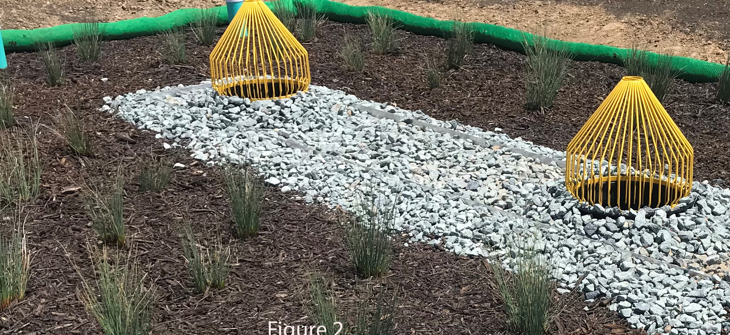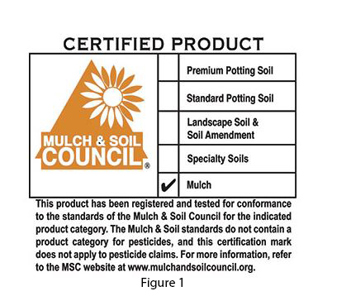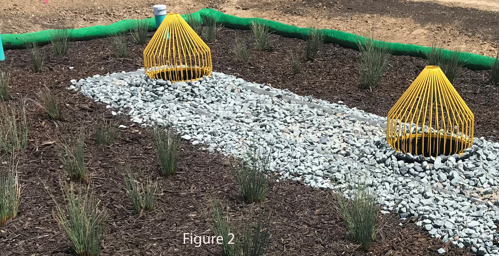
Selecting the Right Mulch for your Biofiltration Practice
The Role of Mulch in Biofiltration: What to Use and Why It Matters
As a biofiltration surface layer, mulch can support water retention, weed suppression, organic replenishment, pollutant treatment, aesthetics, media protection from scour, and moderate media temperature. Landscape mulches can include organic mulches like fresh wood chips or aged composted mulch, as well as inorganic mulches such as rock and rubber mulch. Factors driving selection of mulch type for surface application can include landscape design, climate, planting material, availability and budget.
Organic wood mulch is often a byproduct of the lumber industry (typically shredded bark), wood recycling centers (i.e. pallets) or processed yard waste from public landfills. Other mulches can include grass clippings, pine needles, straw, sawdust, leaf litter, turf, coir and compost, but these should be avoided for biofiltration applications, particularly high flow media, to prevent hydraulic restriction, flotation, maintenance burdens and nutrient leaching among other issues. Composted or aged wood mulch, which is mulch that has had time to decompose, is a better option over fresh wood mulch for use in most landscape practices, including biofiltration. Composted mulch is typically free of disease, insects and weed seeds. Fresh wood mulch can remove nitrogen from the soil, which may be beneficial to nitrogen removal from stormwater, but can strip nitrogen away from landscape plants. Fresh wood mulch is typically available as wood chips and can be more prone to floating, exposing the media surface to erosion and obstructing overflows. Wood chips typically are not as shredded and decomposed as composted mulch which tends to more easily form a mat after a few storm events due to its more fibrous structure.
Aged wood mulch is commonly available as bark nuggets, and as both shredded softwood (such as cedar or fir) and hardwood. Wood mulch feedstock may be dictated by region as softwoods are more prevalent on the west coast of the U.S. and hardwoods on the east coast. A double shredded bark 3-inch mulch layer is generally used in biofiltration practices. Triple shredded bark mulch may contain too many fines and single shredded may contain larger mulch more prone to floating. Bark nuggets should also be avoided to prevent floating as they are less dense. When softwoods are used, texture should be evaluated as some softwoods can be somewhat “mouse-nest” in appearance and contribute to floating.
Wood mulch is beneficial due to the additional treatment performance it provides to a biofiltration practice. The media stays protected, and infiltration rates maintained while most of the sedimentation occurs on the surface of the mulch within a biofiltration practice. Published research supports greater metals adsorption capacity for hardwood mulch due to its intrinsic properties including humic compounds consisting of carboxyl and hydroxyl functional groups, and greater cation exchange capacity, surface area and pH. Wood mulch is also known to capture oil and grease among other organic compounds. Wood mulch is also a host for microbial and macro-organism activity which supports plant health and pollutant degradation. Wood mulch sustains organic-based removal mechanisms as the mulch is decomposed and replenishes organic material within the media, also preserving water-holding capacity.
 As good practice, recycled yard waste from public municipalities or recycled wood scraps such as pallets should be avoided due to inconsistencies in source and potential for unwanted trash or chemical additives in the mulch. To ensure you are selecting a quality mulch for your biofiltration practice, it is a good rule of thumb to ensure it has the Mulch & Soil Council Certification emblem on the bag (Figure 1). Mulch products with this certification must pass rigorous screening and are periodically audited to ensure the products meet Council standards. The certification ensures the product label is accurate and all ingredients are listed, and product claims have been verified. A Mulch & Soil Certification also ensures the mulch contains no chromated copper arsenate, which is a wood preservative found in recycled pilings, utility poles and highway structures. If mulch is not available that is certified by the Mulch & Soil Council, it should be free from waste wood material, harmful chemicals, or inorganic dyes. Mulch should not contain any fertilizer, pesticide, or other amendment. If mulch is being used in a nutrient sensitive area, a leachate analysis would ensure the mulch does not contribute to nutrient leachate from the practice.
As good practice, recycled yard waste from public municipalities or recycled wood scraps such as pallets should be avoided due to inconsistencies in source and potential for unwanted trash or chemical additives in the mulch. To ensure you are selecting a quality mulch for your biofiltration practice, it is a good rule of thumb to ensure it has the Mulch & Soil Council Certification emblem on the bag (Figure 1). Mulch products with this certification must pass rigorous screening and are periodically audited to ensure the products meet Council standards. The certification ensures the product label is accurate and all ingredients are listed, and product claims have been verified. A Mulch & Soil Certification also ensures the mulch contains no chromated copper arsenate, which is a wood preservative found in recycled pilings, utility poles and highway structures. If mulch is not available that is certified by the Mulch & Soil Council, it should be free from waste wood material, harmful chemicals, or inorganic dyes. Mulch should not contain any fertilizer, pesticide, or other amendment. If mulch is being used in a nutrient sensitive area, a leachate analysis would ensure the mulch does not contribute to nutrient leachate from the practice.
Inorganic mulches commonly available include rock mulch, landscape fabric, plastic sheeting and rubber mulch from recycled tires. While this is a preferred method for some landscapes since it does not degrade as easily and sometimes require less maintenance, inorganic mulches are generally not optimal choices for biofiltration practices as they do not maintain or improve media quality over time. Decomposition of organic mulch replenishes organic material in the underlying media to aid in sustained pollutant adsorption. However, rocks or pavers can serve as great anti-scour control around inlet areas, and rock mulch is sometimes selected if the treatment area will be subject to major scouring due to multiple inlets. Rock mulch provides color and shape variety in selection for aesthetic value and does not float, but maintenance of rock mulch may be more difficult and rock mulch is heavier and more expensive. Rock particle size should be taken into consideration as well as ensuring it is a washed product if rocks are used. Since rock mulch can be quite large, care should be taken to maintain the design ponding depth. Other inorganic mulches like rubber mulches from recycled tires have also been considered for bioretention systems as an alternative to wood mulch. However, research has shown the potential for toxicity to aquatic organisms from rubber mulches so caution should be taken when considering this type of mulch.
Qualifying mulch feedstock properties for consistency, texture and size helps ensure the mulch will not restrict flow, but also provide necessary pretreatment performance. Mulch with excessive fines or sediment should be avoided as this can reduce infiltration rates, but most mulch sizes should be less than 1 inch. Figure 2 illustrates a shredded hardwood mulch with ideal consistency and texture. Wood mulch can contain additives such as compost, but this should be avoided as a surface layer for biofiltration practices. Mulch particle size and texture not only affects hydraulic function but also floatability. If floating wood mulch is unavoidable, an open mesh netting can be staked over the surface to prevent mulch from escaping the practice. For a quick float qualification test, place mulch in a clear container filled with water. Stir to ensure even wetting and wait approximately 24 hours to observe if most of the mulch has settled.

Wetting wood mulch at installation and ensuring it receives irrigation will reduce the chance of mulch floating from the practice. The wetting and drying process allows caking or matting to occur. Inlet areas, or other areas receiving concentrated flow, should be designed with dissipator stones or other type of erosion control. Denser plant covers can also reduce mulch flotation. Mulch with higher moisture content and therefore greater density can also minimize floatability. Bark nuggets and wood chips should be avoided due to their lighter density and texture that lends itself to increased floatability.
Availability and supply method are also important factors to consider. Sometimes it is more economical to purchase bulk mulch over bagged mulch depending on the size of the biofiltration practice, but bagged mulch can be easier to handle. If you are qualifying mulch you should make sure what you are testing is available year-round so that when it is time for mulch installation you can ensure the qualified product is available. Mulch is a natural product that can change over time, so periodic supplier quality checks are important.
Selecting the right mulch for your biofiltration practices will help ensure sustained hydraulic and pollutant adsorption function. Mulch is the first layer stormwater contacts in a biofiltration practice, and typically the first line of defense for treatment. Taking the time to perform quality checks will protect the underlying treatment media and reduce the maintenance burden, preserving the life of the practice to ensure it functions as designed.
